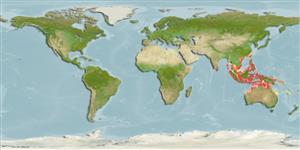Actinopterigi (pesci con pinne raggiate) >
Perciformes (Perch-likes) >
Polynemidae (Threadfins)
Etymology: Polydactylus: Greek, poly = a lot of + greek, daktylos = finger (Ref. 45335).
Ambiente / Clima / Range
Ecologia
; marino; salmastro demersale; distribuzione batimetrica 2 - 55 m (Ref. 57343). Tropical, preferred ?; 26°N - 11°S, 77°E - 154°E (Ref. 57343)
Eastern Indian Ocean and Western Pacific: Tamil Nudu, India to Myanmar and Phuket, Thailand; then from Taiwan to Indonesia and New Caledonia.
Size / Peso / Age
Maturity: Lm ? range ? - ? cm
Max length : 25.0 cm TL maschio/sesso non determinato; (Ref. 3479); common length : 20.0 cm TL maschio/sesso non determinato; (Ref. 3479)
Spine dorsali (totale): 9; Raggi dorsali molli (totale): 12-14; Spine anali 3; Raggi anali molli: 11 - 12; Vertebre: 10 - 14. With 5 pectoral filaments; uppermost not reaching to (or extending slightly beyond) posterior tip of pectoral fin. Pectoral fin, rays short, 17-20% of SL; all rays branched except uppermost 1 or 2. Second dorsal spine long, 7-9% of SL. Well-developed swim bladder. A large black spot anteriorly on lateral line (Ref. 40958). Posterior margin of maxilla reaching to (or slightly short of) level of posterior margin of adipose eyelid. Lower tip of 7th proximal pterygiophore of 1st dorsal fin directed backwards. Lateral line squamation on caudal fin unbranched, extending to upper end of lower caudal fin lobe (Ref. 40970).
Found in turbid coastal waters, estuaries and mangrove creeks, and in mangrove-lined rivers (Ref. 57343). Euryhaline (Ref. 12743). Feeds mainly on small crustaceans (especially shrimps), fishes and benthic organisms (Ref. 3479).
Life cycle and mating behavior
Maturità | Riproduzione | Deposizione | Uova | Fecundity | Larve
Motomura, H., 2004. Threadfins of the world (Family Polynemidae). An annotated and illustrated catalogue of polynemid species known to date. FAO Spec. Cat. Fish. Purp. Rome: FAO. 3:117 p. (Ref. 57343)
IUCN Red List Status (Ref. 115185)
CITES (Ref. 94142)
Not Evaluated
Threat to humans
Harmless
Human uses
Pesca: di nessun interesse
Informazioni ulteriori
Nomi ComuniSinonimiMetabolismoPredatoriEcotossicologiaRiproduzioneMaturitàDeposizioneFecundityUovaEgg development
BibliografiaAcquacolturaProfilo di acquacolturaVarietàGeneticaFrequenze allelicheEreditarietàMalattieElaborazioneMass conversion
Strumenti
Special reports
Download XML
Fonti Internet
Estimates of some properties based on models
Phylogenetic diversity index (Ref.
82805): PD
50 = 0.5000 [Uniqueness, from 0.5 = low to 2.0 = high].
Bayesian length-weight: a=0.01698 (0.01024 - 0.02815), b=3.04 (2.90 - 3.18), in cm Total Length, based on LWR estimates for this species & (Sub)family-body (Ref.
93245).
Trophic Level (Ref.
69278): 3.9 ±0.0 se; Based on diet studies.
Resilienza (Ref.
69278): Alto, tempo minimo di raddoppiamento della popolazione meno di 15 mesi (Preliminary K or Fecundity.).
Vulnerability (Ref.
59153): Low vulnerability (17 of 100) .
